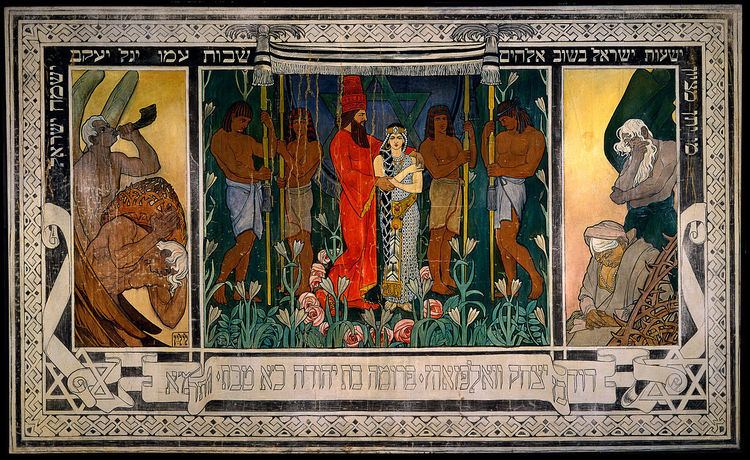 | ||
The Bezalel school was an art movement in Palestine in the late Ottoman and British Mandate periods. Named for the Bezalel Art School, predecessor of the Bezalel Academy of Art and Design, it has been described as "a fusion of 'oriental' art and Jugendstil."
Style and themes
The Bezalel school artists blended varied strands of surroundings, tradition and innovationin paintings and craft objects that invoked biblical themes, Islamic design and European traditions in their effort to carve out a distinctive style of Jewish art for the new nation planned in the ancient Jewish homeland. The works of art created by the group contributed significantly to the creation of a distinctive Israeli national culture.
The founder of the school was Boris Schatz, who left his position as head of the Royal Academy of Arts in Sofia, Bulgaria, to make aliyah 1906 and established an academy for Jewish arts in Jerusalem. The artists were Zionist immigrants from Europe and the Middle East, with all the psychological and social upheaval that this implies. The movement developed a distinctive style combining Biblical and Zionist subjects with art nouveau, symbolism and traditional Persian and Syrian artistry.
The Bezalel School produced decorative art objects in a wide range of materials: silver, leather, wood, brass and fabric. While the artists and designers were European-trained, the craftsmen who executed the works were often members of the Yemenite Jewish community, which had a long tradition of craftsmanship in precious metals, and began to make aliyah about 1880. In Yemen, filigree jewelry making was a respected profession among the Jews, with cultural as well as religious applications. Yemenite Jewish craftsmen worked primarily with silver, creating pieces by hand using traditional methods. Yemenite immigrants wearing colorful traditional costumes were also frequent subjects of Bezalel School artists.
Leading members of the school were Boris Schatz, E.M. Lilien, Ya'akov Stark, Meir Gur-Aryeh, Ze'ev Raban, Jacob Eisenberg, Jacob Steinhardt, Shmuel Ben David, and Hermann Struck.
The artists produced not only paintings and etchings, but objects sold as Judaica and souvenirs. In 1915, the New York Times praised the “Exquisite examples of filigree work, copper inlay, carving in ivory and in wood,” in a touring exhibit.
In the metalwork Moorish patterns predominated, and the damascene work, in particular, showed both artistic feeling and skill in execution.
